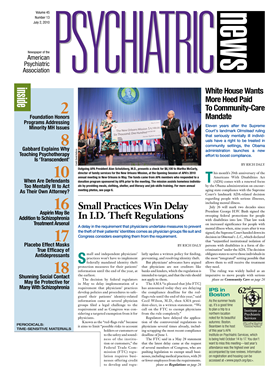Patients assault psychiatrists four times more frequently than physicians in general, a statistic that members of the profession ought to keep in mind every day, said Robert Simon, M.D., at APA's 2010 annual meeting in New Orleans in May.
Simon and Kenneth Tardiff, M.D., M.P.H., were named the winners of the 2010 Manfred S. Guttmacher Award, presented for co-editing the Textbook of Violence Assessment and Management, published by American Psychiatric Publishing Inc.
“We have to recognize that every health care professional is a potential target of the rare, but ever-present, risk of patient violence,” said Simon in his portion of the lecture.
Simon asked how many in the audience had ever been assaulted by a patient. About one-third raised a hand, a close approximation of past surveys showing that 40 percent of psychiatrists have been attacked during their careers. That is the result of having an annual rate of 68 nonfatal violent crimes per 1,000 psychiatrists compared with about 16 per 1,000 physicians overall.
Safety measures should be an integral part of clinical practice, said Simon, a clinical professor of psychiatry and director of the Program in Law and Psychiatry at Georgetown University School of Medicine.
The deaths in recent years of two mental health clinicians provided cautionary insights into patient violence. Psychiatrist Wayne Fenton, M.D., was beaten to death in 2006 by a patient whom he saw alone in his office on a weekend. Having an escape route from the room and the presence of a third party who could be summoned by a silent alarm might prevent such outcomes, said Simon.
He also noted the murder of Katherine Faughey, Ph.D., killed by a patient of an office suitemate in 2008. The killer had not even seen the other clinician for 17 years, but nursed a murderous grudge during that time and took it out on Faughey, whom he had never previously met.
“Wherever there is a patient, there is the potential for violence,” said Simon. “You are not invulnerable.”
Patient violence can occur anywhere, he said. The emergency room is the riskiest place. Patients are unscreened, there is no therapeutic alliance established, patients may have used toxic substances, and guns and knives may be in their back pockets. However, the emergency room is also best equipped and trained to handle potential violence. The worst place is probably the home office, where there is no secretary or security guard to call.
Patient violence can take many forms in addition to physical attacks. The Internet provides a starting point for many who wish ill for their therapists. Web searches, forums, chat rooms, and social networking sites all provide ways to find a doctor. Google provides not only street maps but also pictures of residences on those streets. Information about one's personal life and family members is readily available, too. False accusations abound on the Internet.
Google yourself? “I'm afraid of what I'm going to find,” said Simon.
Cyberstalking takes cybersnooping one step further.
“Take it seriously,” said Simon. “Never arrange to meet anyone harassing you.”
A restraining order won't necessarily stop such behavior, but it will provide some recourse if violated.
If threats start to escalate, the psychiatrist should verbally engage the patient, actively respond to threat behaviors, try to summon help, and have an escape route planned.
In a clinical setting, a psychiatrist may not have much time to assess whether a patient is likely to resort to violence in the short term, said Tardiff, a professor of psychiatry and public health and an attending psychiatrist at the Payne Whitney Clinic of the New York Hospital-Cornell Medical Center.
A history of violence is the prime risk factor for future acts.
“Treat a history of violence like any other symptom,” said Tardiff. “The gateway questions should be: Have you ever gotten into a fight? When? What were you thinking? How badly were you or the other person injured?”
Beyond that, the psychiatrist should probe for specific plans for violence, access to the victim, and available means, he said. “For example, move to get a gun out of the house, not just hide it, then get the patient into treatment.”
Look, too, for a history of child abuse or other intrafamilial violence, brain trauma, and impulsive behavior, like dangerous driving, suicide attempts, or gambling, he said.
“You're not compiling a rating scale,” said Tardiff. “You're making a global medical decision by framing an opinion and weighing all the factors.”
Psychiatric disorders have variable connections to violent behavior, he said. Here are some examples:
•.
Violence is rare among people with depression unless it is accompanied by psychosis or delusions of guilt.
•.
In intermittent explosive disorder, violence is often related to stress, the patient seems calm between episodes, and the patient expresses remorse after the blowup.
•.
In antisocial personality disorder, the patient typically does not express postviolence regret and leads a chaotic life—lying, cheating, and stealing.
•.
With borderline personality disorder, violence is often related to rejection or perceived rejection by others.
•.
Violence is rare among people with paranoid personalities, but it may be extreme when it does happen. Prediction is difficult, so monitoring to detect change in ideation may have to serve.
•.
People with schizophrenia can become violent for reasons other than as a symptom of their psychosis. A patient with akathisia may bump into someone while walking around the day room, and the incident escalates into a fight, or violence may be “goal-directed,” intended to influence others or get what the patient wants.
•.
Finally, substance abuse serves as an added layer of risk under any circumstances. Alcohol reduces inhibition and impairs cognition.


